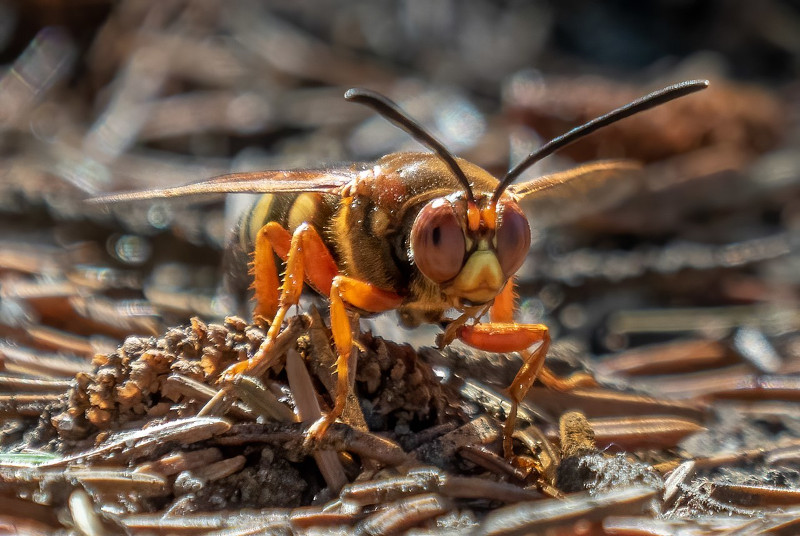
Eastern Cicada Killer Facts
- This visually impressive creation of evolution most frequently goes by the somewhat deceptive common name of the Eastern Cicada Killer. The insect does have several other, less often used names, though. These include cicada hawk and cicada killer.
- Within scientific circles, however, it’s generally referred to by its technical title. Unfortunately, though, that’s a slightly difficult term to pronounce for the layperson. That’s because this fabulous Arthropod bears the official name of Sphecius speciosus.
- It received that tongue-twisting moniker due to the efforts of the British entomologist, Dru Drury. He accomplished the first acknowledgement of it as a separate and distinct species. The researcher managed this scientifically noteworthy deed in the year 1773.
- Though intriguing, the name remains somewhat confusing. That’s due to the fact that the same term’s frequently applied to a number of different species with its feeding habits. They’re also occasionally referred to as sand hornets, though not hornets.
- Luckily, the Eastern Cicada Killer appears to be maintaining a population base that’s both stable and sufficient. That fortunate trend further seems to hold true throughout the entirety of its range. The IUCN, therefore, has no listing for it on the Red List.
- Nevertheless, this wonder of Nature must be considered to be facing at least some potential threats to its existence as a species. Habitat degradation and outright loss pose potential dangers. Its greatest threat, though, likely consists of climate change.
Related Articles
Eastern Cicada Killer Physical Description
The fascinating Eastern Cicada Killer quickly gains the appreciation of those who respect Nature. Unlike some species, however, it does so for several reasons. In its case, this occurs due to a combination of both its visual appeal and its sheer physical measurements.
Like many insects, it additionally displays a certain degree of the physiological characteristic of sexual dimorphism. In its specific situation, though, this trait manifests itself in terms of pure size. More precisely, females attain a larger average size than their male counterparts.
Both genders, though, vary significantly in body length, due to various local environmental factors. Overall, however, mature adults reach average total lengths ranging from 0.6 – 2 in (1.5 – 5 cm). Although rare, exceptional individuals sometimes exceed this length.
Otherwise, specimens of both sexes remain virtually indistinguishable to untrained observers. The general form is often described as robust, though elongated, as most of its kind. Its general appearance, in fact, resembles several species of yellowjacket and hornet.
The head of the Eastern Cicada Killer develops as comparatively large in relation to body size. Its eyes also attain a relatively large size for its kind. The long, jointed legs generally display a bright orange-yellow shade. The wings, meanwhile, show a light or dark brown hue.
It’s the body of this distinctive Hymenoptera that mosts catches the eye, though. The thorax, or middle section, shows reddish and black colors, along with a covering of dense hairs. It abdomen, however, manifests a black background, along with bright yellow stripes.
- Kingdom: Insecta
- Phylum: Arthropoda
- Class: Insecta
- Order: Hymenoptera
- Family: Crabronidae
- Genus: Sphecius
- Species: S. speciosus
Eastern Cicada Killer Distribution, Habitat, and Ecology
The impressive Eastern Cicada Killer evolved as native to a moderately broad swathe of the world. That’s also a region of the globe well known for its abundance of natural marvels. That’s true since it evolved as endemic to a portion of the continent of North America.
That’s where the mild deceptiveness of its name comes into play, though. It’s true that the invertebrate appears in the eastern sections of the United States, to be sure. Yet, it also lives in the midwest part of the country, in addition to Mexico and parts of Central America.
This intrepid creation of evolution developed as highly versatile and adaptible in its choice of habitat, too. That’s a large aid in its survival. Within its native range, the insect makes its home in a wide range of locations. This even includes around areas of human habitation.
It makes its home by burrowing into the ground, to construct a nest. To do so, it merely requires the soil to be well-drained, preferably sandy or loose clay in composition. It often appears in areas of grass-covered banks and hills, and next to raised sidewalks and patios.
The Eastern Cicada Killer evolved as solitary in nature, unlike more eusocial species. Adults emerge in summer, usually late June or early July. These typically feed on a wide variety of flowers for their nectar, as well as the sweet sap of various locally available plants.
Males tend to be quite aggressive towards each other, establishing breeding dominance. To humans, though, they pose no dange, since they have no stinger. Only females possess this appendage, using it to stun their prey. Their main food consists of cicadas, thus the name.
Species Sharing Its Range
Check out our other articles on 3 Surprising Sahara Desert Sites, Philippine sailfin lizard, Deception Island, Rosy Veincap, Shoebill, Ribbon Seal, Southern Darwin’s Frog, East African Lowland Honey Bee
